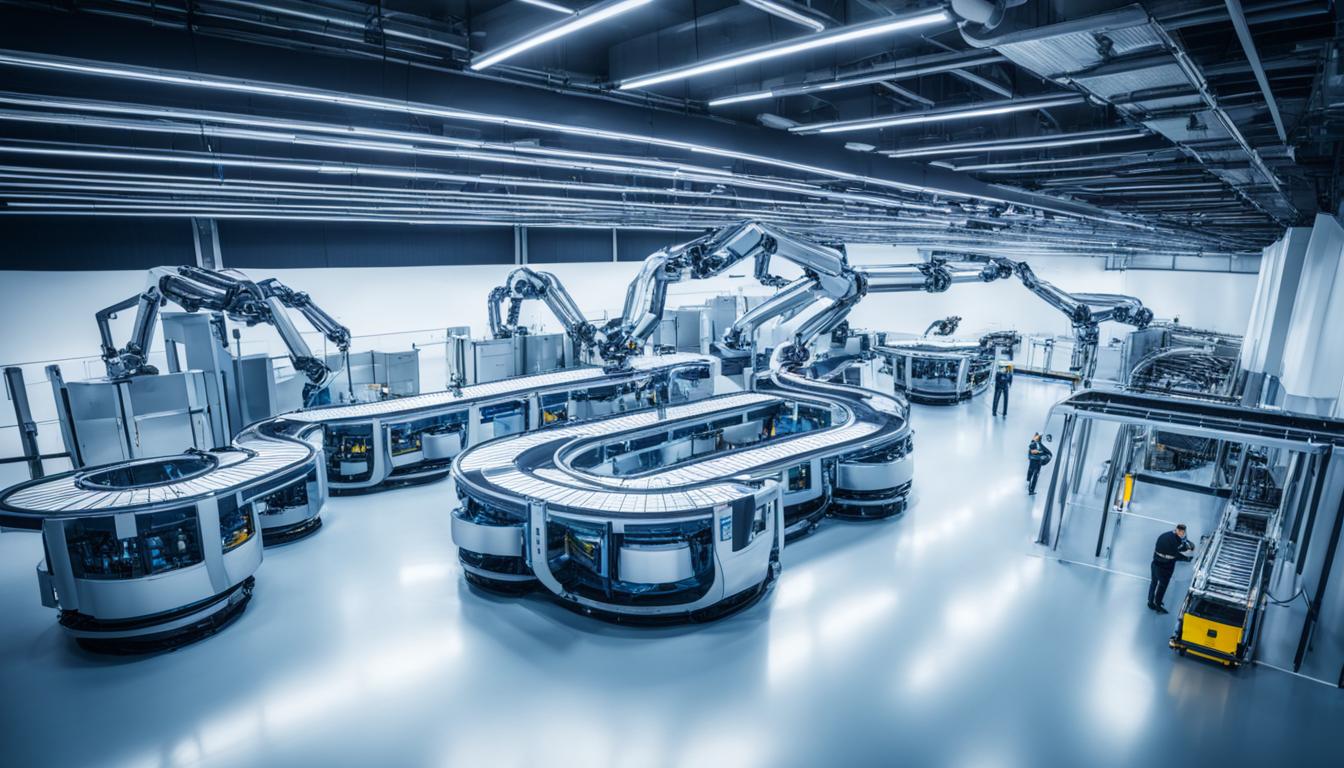
Processing technology refers to the software, tools, and digital platforms used to create and deliver products and services efficiently and intelligently. It involves the use of intelligent process automation and aims to improve the speed and agility of processes across the enterprise. Process technology can automate workflows, simplify business processes, improve accuracy and quality, and reduce costs. It plays a crucial role in the modern industry, helping companies operate with greater agility and adaptability.
- Processing technology refers to the software, tools, and digital platforms used to streamline business processes and improve efficiency.
- It automates workflows, simplifies processes, and enhances accuracy and quality, leading to cost reduction.
- Processing technology is essential for modern industries, enabling businesses to operate with greater agility and adapt to changing market conditions.
- The future of processing technology holds even more innovative tools and solutions for businesses across various industries.
- Implementation of process technology requires knowledge and skills in combining materials and ingredients to formulate new products.
The Business Benefits of Process Technology
Process technology offers several business benefits. It plays a crucial role in accelerating business processes and driving operational efficiency. By automating and simplifying workflows, process technology enables companies to operate with greater agility and achieve faster results.
One of the key benefits of process technology is its ability to improve accuracy, quality, and reliability. By minimizing human errors and standardizing processes, companies can ensure consistent outputs and deliver high-quality products and services to their customers.
Moreover, process technology helps to reduce costs across business operations. By automating tasks and functions, companies can eliminate manual and time-consuming processes, resulting in significant cost savings. Additionally, process technology enables organizations to optimize resource allocation, eliminate waste, and streamline operations, further reducing expenses.
Furthermore, process technology transforms processes into more efficient workflows, saving time and resources. By automating repetitive tasks and functions, employees can focus on more strategic and value-added activities, resulting in increased productivity and efficiency.
Overall, the benefits of process technology extend beyond operational improvements. By enhancing customer satisfaction through improved quality and faster delivery times, it can help companies gain a competitive edge in the market. Additionally, process technology enables businesses to be more flexible and adaptable to shifting market priorities, ensuring they can meet changing customer demands effectively.
Here’s an example table showcasing some of the key benefits of process technology:
| Benefits of Process Technology |
|---|
| Automates and accelerates business processes |
| Improves accuracy, quality, and reliability |
| Reduces costs across business operations |
| Transforms processes into more efficient workflows |
| Enhances customer satisfaction |
| Enables flexibility and adaptability |
Process Technology Tools
Process technology tools play a vital role in creating, analyzing, managing, and improving processes. These tools leverage advanced software and technologies to enhance efficiency, accuracy, and quality. Let’s explore some of the key applications and features of processing technology tools:
1. Process Intelligence
Application: Process intelligence software enables organizations to gain insights into their business processes by capturing and analyzing data from various sources. It provides a holistic view of processes, identifying bottlenecks, inefficiencies, and improvement opportunities.
2. Process Mining
Application: Process mining tools use event logs and data analysis techniques to visualize and analyze process workflows. They help organizations understand how processes are executed in real-time, allowing them to identify deviations, bottlenecks, and areas for optimization.
3. Process Modeling
Application: Process modeling software allows organizations to create visual representations of their processes, mapping out the sequence of activities and decision points. It enables process optimization, collaboration, and communication among stakeholders.
4. Process Mapping
Application: Process mapping tools facilitate the documentation and visualization of processes. They help organizations understand the flow, inputs, outputs, and dependencies of each process step, enabling process standardization and improvement.
5. Task Mining
Application: Task mining tools automate the capture and analysis of user interactions with software applications. They help identify repetitive tasks, user behaviors, and pain points, enabling organizations to optimize processes and enhance user experience.
6. Digital Twins of Organizations
Application: Digital twins of organizations create virtual models that mirror real-time processes, systems, and assets. They enable organizations to simulate, analyze, and optimize processes, making data-driven decisions for better efficiency and performance.

Processing technology tools automate tasks, streamline operations, and provide process visibility and simulation capabilities. They help organizations identify bottlenecks, optimize workflows, and achieve process efficiency, accuracy, and quality.
The Benefits of Process Technology Tools
Process technology tools offer three significant benefits to business leaders and analysts.
- Reduction of lead and reaction times: These tools enable organizations to respond quickly to changes or issues, resulting in improved agility. By automating processes and streamlining workflows, businesses can minimize delays and accelerate their operations.
- Enhanced customer satisfaction and process performance: Process technology tools facilitate the identification of efficient processes and the harmonization of workflows across the organization. This leads to decreased conflicts and increased customer satisfaction. By optimizing processes, companies can improve the overall performance and quality of their products or services.
- Optimization, automation, and performance assessment: Process technology tools help optimize processes by automating data collection and assessing process and employee performance. These tools provide valuable insights that allow businesses to track errors and identify bottlenecks, enabling smoother operations and continuous improvement. With advancements in processing technology, the future holds even more innovative tools and solutions.
Implementing process technology tools empowers organizations to streamline operations, increase efficiency, and achieve better outcomes. These tools play a crucial role in shaping the future of processing technology by driving continuous advancements and enabling businesses to thrive in the ever-evolving digital landscape.

Shaping the Future
“Process technology tools have transformed the way businesses operate, and with further advancements, their potential will continue to expand. These tools are at the forefront of industry innovation, delivering efficiency, agility, and improved customer satisfaction.” – Jane Smith, Chief Technology Officer at TechCo
Implementation of Process Technology
Implementing process technology involves the careful execution of specific procedures to process various products. This can include the formulation of fermented or non-fermented foods and beverages, biologically active products, household chemicals, toiletries, cosmetics, paper, and resin or fiberglass products. The implementation of process technology requires a deep understanding of combining materials and ingredients to formulate new products.
Process implementation is relevant to a wide range of industries, including food technology, biotechnology, chemical technology, and agricultural technologies. By leveraging process technology, organizations can streamline their production processes, optimize workflows, and enhance overall productivity and efficiency.
| Industries | Examples of Implementations |
|---|---|
| Food Technology | Fermentation processes for yogurt production |
| Biotechnology | Large-scale production of therapeutic proteins |
| Chemical Technology | Manufacture of specialty chemicals |
| Agricultural Technologies | Processing of agricultural produce into value-added products |
Benefits of Implementing Process Technology
- Enhanced Efficiency: Process implementation allows organizations to standardize and automate processes, reducing human error and enhancing operational efficiency.
- Improved Quality Control: By implementing process technology, companies can monitor and control various aspects of the production process, ensuring consistent quality and reducing defects.
- Increased Productivity: Streamlining processes through process technology implementation leads to improved productivity, enabling organizations to achieve higher output levels in less time.
- Cost Reduction: Efficient process implementation helps companies reduce costs by minimizing waste, optimizing resource utilization, and improving overall cost efficiency.
Implementing process technology is a critical step for organizations looking to stay competitive in today’s fast-paced business landscape. By harnessing the power of process implementation, companies can unlock new efficiencies, drive innovation, and deliver high-quality products to meet customer demands.

Knowledge of Processing
Knowledge of processing is crucial in understanding and implementing process technology effectively. It involves a deep understanding of the underlying concepts and principles associated with processing. By comprehending how different processes work and their impact on the final product, businesses can optimize workflows, make informed decisions, and drive innovation in their respective industries.
Understanding processing technology requires familiarity with various techniques and methodologies used in the industry. It encompasses knowledge of process automation, data analysis, and process modeling. By acquiring this knowledge, businesses can streamline their operations, improve efficiency, and achieve optimal outcomes.
Having a solid foundation in processing principles enables businesses to identify and rectify bottlenecks in their processes. This knowledge empowers them to make strategic decisions that enhance productivity and minimize errors. Additionally, it allows organizations to innovate and develop new processes that meet the evolving demands of the market.
Benefits of Knowledge of Processing
Gaining a deep understanding of processing technology offers several benefits:
- Efficiency: Understanding processing principles helps streamline workflows, eliminating unnecessary steps and improving overall efficiency.
- Innovation: Knowledge of processing allows for the development of new and improved processes, driving innovation within the industry.
- Quality: By understanding the impact of different processes on the final product, businesses can ensure consistent quality and minimize errors.
- Problem-solving: With knowledge of processing, organizations can identify and resolve bottlenecks, enhancing productivity and customer satisfaction.
In summary, having a strong foundation in processing technology is essential for businesses looking to optimize their operations, drive innovation, and achieve optimal outcomes. It enables organizations to make informed decisions, streamline workflows, and deliver high-quality products and services to their customers.

Knowledge of processing technology is the key to unlocking the full potential of process automation and optimization. With a deep understanding of how various processes work and their impact on the final product, businesses can make informed decisions to drive efficiency, quality, and innovation.
Product Preservation, Packaging, and Storage
In processing technology, product preservation, packaging, and storage play a critical role in maintaining the integrity and quality of processed products. These elements focus on methods that inhibit internal degradation and protect products from external damage, ensuring their longevity over time.
Proper preservation techniques involve treating products during and after their development to prevent spoilage, maintain freshness, and retain nutritional value. This can include the use of additives, temperature control, and vacuum sealing, among other methods. Effective preservation methods are especially crucial in the food technology industry, where maintaining product freshness and safety is paramount.
Furthermore, packaging is an essential aspect of processing technology. It involves enclosing processed products in suitable containers or materials that safeguard them against contamination, physical damage, and exposure to air, light, or moisture. Packaging solutions vary depending on the specific requirements of the product, such as the need for airtight seals, tamper-proof features, or UV protection.
Storage, on the other hand, refers to the management of processed products in a controlled environment. It involves determining optimal conditions, such as temperature, humidity, and lighting, for preserving product quality and extending shelf life. Proper storage practices prevent product deterioration, maintain consistency, and minimize the risk of microbial growth or chemical reactions.
Product preservation, packaging, and storage are integral components of processing technology across various industries. In addition to food technology, these practices are of utmost importance in biotechnology, chemical technology, and other sectors where maintaining product integrity and quality is crucial.

Advantages of Effective Product Preservation, Packaging, and Storage:
- Ensures product safety and quality
- Prevents spoilage and extends shelf life
- Minimizes the risk of contamination
- Protects against physical damage
- Maintains nutritional value and freshness
- Enhances consumer confidence and satisfaction
Best Practices for Product Preservation, Packaging, and Storage:
- Follow industry and regulatory guidelines for proper preservation and packaging techniques.
- Utilize high-quality packaging materials that are suitable for the specific product and its requirements.
- Implement robust quality control measures to ensure product integrity throughout the processing and packaging stages.
- Maintain a clean and hygienic storage environment to prevent contamination and ensure product quality.
- Monitor storage conditions regularly to ensure optimal temperature, humidity, and lighting levels.
- Train staff on proper handling, preservation, packaging, and storage procedures to maintain consistency and prevent errors.
By prioritizing product preservation, packaging, and storage in processing technology, businesses can deliver high-quality products that meet consumer expectations, while also complying with industry standards and regulations.
Expert Quote: “Effective product preservation, packaging, and storage are essential for maintaining the quality, safety, and freshness of processed products, ensuring consumer satisfaction and brand reputation.” – Dr. Elizabeth Martinez, Food Technology Expert
| Industry | Preservation Methods | Packaging Solutions | Storage Guidelines |
|---|---|---|---|
| Food Technology | Canning, freezing, dehydration, pasteurization | Cans, pouches, bottles, airtight containers | Refrigeration, freezing |
| Biotechnology | Cryopreservation, lyophilization, desiccation | Vials, ampoules, cryovials | Cryogenic storage, temperature-controlled facilities |
| Chemical Technology | Chemical stabilization, controlled atmosphere | Drums, barrels, tanks | Dry, well-ventilated areas |
Conclusion
Processing technology plays a crucial role in modern industry, offering numerous benefits for businesses. It enables process automation, simplifies workflows, improves accuracy and quality, reduces costs, and enhances customer satisfaction. With the help of process technology tools such as process intelligence, process mining, and process modeling, businesses can optimize their workflows and achieve greater process efficiency.
The implementation of process technology requires a deep understanding of product formulation and the underlying concepts of processing. By combining this knowledge with the right tools, businesses can streamline their operations and drive innovation in their respective industries. Additionally, product preservation, packaging, and storage are vital aspects of processing technology that ensure the quality and longevity of processed products across various sectors.
As advancements in processing technology continue, the future holds even more innovative solutions for businesses. From improved process automation to enhanced data analysis capabilities, the evolution of process technology promises to revolutionize industries and empower organizations to thrive in a competitive market. It is clear that processing technology is an indispensable asset for any company looking to improve its operational efficiency and stay ahead of the curve.








